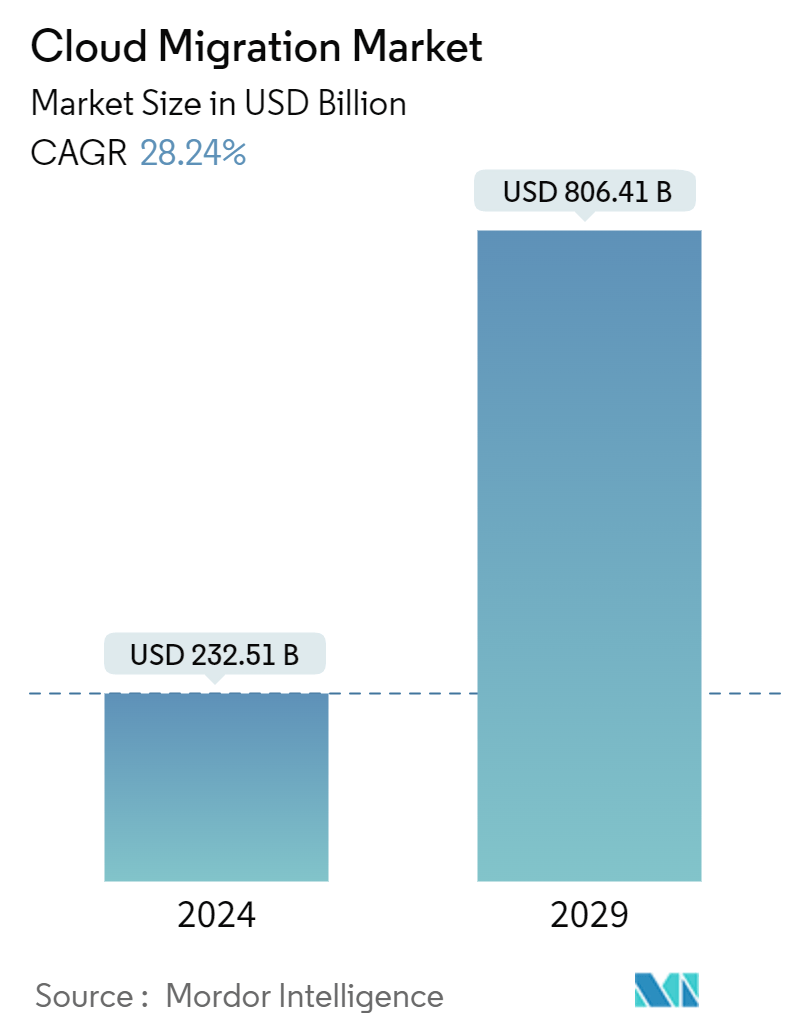Market Size of Cloud Migration Industry

| Study Period | 2019 - 2029 |
| Market Size (2024) | USD 232.51 Billion |
| Market Size (2029) | USD 806.41 Billion |
| CAGR (2024 - 2029) | 28.24 % |
| Fastest Growing Market | Asia Pacific |
| Largest Market | North America |
Major Players
*Disclaimer: Major Players sorted in no particular order |
Cloud Migration Market Analysis
The Cloud Migration Market size is estimated at USD 232.51 billion in 2024, and is expected to reach USD 806.41 billion by 2029, growing at a CAGR of 28.24% during the forecast period (2024-2029).
Over the past decade, cloud computing adoption has risen owing to increasing investments from small and medium enterprises. Globally, many organizations have already switched to cloud platforms to take advantage of its benefits. In recent years, cloud adoption stands to be a significant consideration for IT cost reduction strategies.
- The significant reasons for migrating to the cloud are scalability, increased effectiveness, faster implementation, mobility, and disaster recovery. Considerable companies are offering cloud disaster recovery features to their customers, aiding them in expanding their businesses. Cloud migration is gaining traction for its real-time experience, business elements, and accessibility to on-premise data. This technology also aids in setting up several business units in minimal time.
- The growth of cloud and industrialized services and the decline of traditional data center outsourcing (DCO) indicate a massive shift toward hybrid infrastructure services. While the conventional DCO market is shrinking, spending on colocation and hosting, along with infrastructure utility services, is increasing rapidly. This is expected to drive the shift toward cloud IaaS and hosting. Migration for PaaS, IaaS, and SaaS has been most important in recent years. Companies are also embracing DevOps capabilities and automation; hence, they are increasingly seen as critical to realizing cloud adoption's technical and business benefits.
- The growing demand for cloud migration services is attributed to increased scalability, flexibility, remote collaboration, task automation, improved mobility, and robust data protection. Furthermore, the growing network of connected devices has resulted in massive data growth. As a result, the growing need for a low-cost data storage solution is projected to increase the use of cloud migration services.
- The migration to the hybrid cloud has experienced significant overall growth in the past few years compared to other cloud services. Using a hybrid cloud allows companies to scale computing resources and helps eliminate the need for massive capital to handle short-term spikes in demand. Many cloud providers offer the ability to rapidly increase infrastructure in various worldwide locations, enabling a business to expand to new territories quickly.
- Data security issues and application interoperability issues are expected to hamper the growth of the cloud migration market. Increased internet connectivity and digitization provide opportunities to the cloud migration service offering companies.
Cloud Migration Industry Segmentation
Cloud migration involves the movement of applications, data, and other business elements to a cloud computing environment. There are various types of cloud migrations an enterprise can perform. One standard model is transferring data and applications from a local, on-premises data center to the public cloud. However, a cloud migration could also entail moving data and applications from one cloud platform or provider to another -- a model known as cloud-to-cloud migration. The study has focused on the trend analysis of the adoption of public, hybrid, and private clouds for cloud migration and the type of service provided by the vendors in the market for the application in a wide range of end-user verticals globally. The market estimations indicate the revenues accrued from cloud migration services (the move from on-premises or legacy infrastructure to the cloud) utilised by the enterprises across regions.
The Cloud Migration Market is segmented by type of deployment (public, private, and hybrid), by enterprise size (SMEs and large enterprises), by type of service (PaaS, IaaS, and SaaS), by end-user vertical (BFSI, healthcare, retail, government, IT and telecommunication, manufacturing and other end-user vertical), and by geography (North America, Europe, Asia Pacific, Latin America, Middle East & Africa). The report offers market forecasts and size in value (USD) for all the above segments.
| By Type of Deployment | |
| Public Cloud | |
| Private Cloud | |
| Hybrid Cloud |
| By Enterprise Size | |
| Small and Medium Enterprises (SMEs) | |
| Large Enterprises |
| By Type of Service | |
| PaaS | |
| IaaS | |
| SaaS |
| By End-user Vertical | |
| BFSI | |
| Healthcare | |
| Retail | |
| Government | |
| IT and Telecommunication | |
| Manufacturing | |
| Other End-user Verticals |
| By Geography*** | |
| North America | |
| Europe | |
| Asia | |
| Australia and New Zealand | |
| Latin America | |
| Middle East and Africa |
Cloud Migration Market Size Summary
The cloud migration market is experiencing significant growth, driven by the increasing adoption of cloud computing across various sectors. Organizations are migrating to cloud platforms to leverage benefits such as scalability, enhanced efficiency, and cost reduction in IT operations. The shift from traditional data center outsourcing to hybrid infrastructure services is notable, with a growing emphasis on cloud IaaS, PaaS, and SaaS solutions. This transition is further supported by the rise of DevOps capabilities and automation, which are crucial for realizing the technical and business advantages of cloud adoption. The demand for cloud migration services is fueled by the need for flexible, scalable, and cost-effective data storage solutions, particularly as the volume of data generated by connected devices continues to expand.
In the banking and financial services sector, cloud migration is accelerating due to the need for flexibility, agility, and integration with emerging technologies. Cloud solutions are helping reduce infrastructure costs and support modernization initiatives. Strategic partnerships with cloud service providers are common, enabling organizations to enhance their digital banking capabilities. North America leads in cloud migration innovation, with major players like IBM, Microsoft, and Amazon Web Services driving market growth through strategic collaborations and business expansions. The market is moderately consolidated, with key players focusing on expanding their global presence and increasing profitability through strategic initiatives.
Cloud Migration Market Size - Table of Contents
-
1. MARKET INSIGHTS
-
1.1 Market Overview
-
1.2 Value Chain Analysis
-
1.3 Porter's Five Forces Analysis
-
1.3.1 Threat of New Entrants
-
1.3.2 Bargaining Power of Buyers
-
1.3.3 Bargaining Power of Suppliers
-
1.3.4 Threat of Substitutes
-
1.3.5 Intensity of Competitive Rivalry
-
-
1.4 Assessment of the Impact of COVID-19 on the Market
-
-
2. MARKET SEGMENTATION
-
2.1 By Type of Deployment
-
2.1.1 Public Cloud
-
2.1.2 Private Cloud
-
2.1.3 Hybrid Cloud
-
-
2.2 By Enterprise Size
-
2.2.1 Small and Medium Enterprises (SMEs)
-
2.2.2 Large Enterprises
-
-
2.3 By Type of Service
-
2.3.1 PaaS
-
2.3.2 IaaS
-
2.3.3 SaaS
-
-
2.4 By End-user Vertical
-
2.4.1 BFSI
-
2.4.2 Healthcare
-
2.4.3 Retail
-
2.4.4 Government
-
2.4.5 IT and Telecommunication
-
2.4.6 Manufacturing
-
2.4.7 Other End-user Verticals
-
-
2.5 By Geography***
-
2.5.1 North America
-
2.5.2 Europe
-
2.5.3 Asia
-
2.5.4 Australia and New Zealand
-
2.5.5 Latin America
-
2.5.6 Middle East and Africa
-
-
Cloud Migration Market Size FAQs
How big is the Cloud Migration Market?
The Cloud Migration Market size is expected to reach USD 232.51 billion in 2024 and grow at a CAGR of 28.24% to reach USD 806.41 billion by 2029.
What is the current Cloud Migration Market size?
In 2024, the Cloud Migration Market size is expected to reach USD 232.51 billion.

